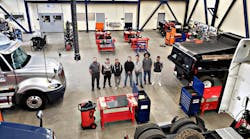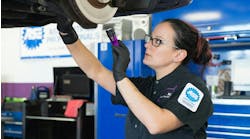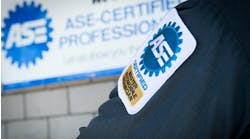Foundation for success: How do you find and keep technician talent?
A recent study conducted by the ASE Education Foundation found that just under half of the graduates surveyed for the 2018-2019 ASE Career Survey left the industry within two years of completing the program.
“That is not sustainable,” says Kyle Holt, President at SP/2, an online training, career services, and apprenticeship provider resource for the vehicle service industry. “We graduate a large number of technicians every year from high school and post-secondary programs… in what universe will we possibly be able to take a bite out of the technician shortage? We've got to do a better job of keeping them in the industry when they get there.”
This issue becomes more critical when reviewing the number of technicians required to fill current job openings compared to the number of graduates entering the industry currently.
“U.S. schools are producing about 5,000 techs a year,” says Tim Spurlock, president and co-founder of American Diesel Training Centers, which offers an accelerated training program for entry-level diesel technicians. “The industry needs about 30,000 to 45,000 [technicians] this year, and that number is growing.” He estimates 12 percent industry growth, which will continue to compound the situation.
The challenge is two-fold: individual shops need to figure out how to hire and retain qualified technicians, and – for long-term sustainability and viability – the industry needs to work together to recruit and retain this talent.
These concerns can be addressed by evaluating current operations’ hiring practices, improving upon assessing qualified candidates, establishing a thorough training program for new hires, and understanding the perspective and drive of the next generation of technicians (potentially) entering the workforce.
Create a sustainable pipeline
George Arrants, a training consultant specializing in ASE and NATEF accreditation, believes the industry must work together in order to advocate for the proper training of incoming technicians. This starts by forming lasting partnerships between local businesses and educators in order to establish industry needs.
“We first need to make sure the schools that are teaching students for our industry are teaching the skills that are important to our industry and not what educators believe we need,” he says.
To begin this process, consider a partnership with a local educational facility that offers a vehicle service training curriculum. Work with local educational facilities and community members to establish a relationship.
“The best successes I have seen have come when businesses engage with local schools to ‘grow their own’ technicians,” says Greg Settle, director – national initiatives, for TechForce Foundation.
TechForce Foundation is a nonprofit 501(c)(3) organization with the mission to assist students through their technical education and into careers as professional technicians.
He says the approach for this is two-fold: establish and maintain a relationship with local educational facilities and create internship programs.
Relationships can start through an introduction between the shop staff and the instructors, followed by a company representative participating on the school’s diesel or automotive service advisory board, Settle says. To foster that relationship, consider ways to give back to the school through donating time, parts, tools, or other training opportunities for students. Participation in career fairs or inviting students to tour a fleet’s facility can also connect educators to local businesses.
As that relationship evolves between the business and school, fleets can establish paid internship or apprenticeship programs, where students receive hands-on training at a service facility.
“By doing this, they engage the students while they are still in school and start building a relationship with them and get to know them,” Settle explains. “The students also get to know the organization and gain a sense of belonging.”
Local engagement is key to being a resource for educators and for appealing to graduating students who are looking for entry-level positions within the industry.
“If you are working with a school, and the instructor[s] there know you and have a relationship with you, and the students know you, then your organization will have an upper hand in attracting those students upon graduation,” Settle says.
One example of this can be found in Fresno, California, where a number of vehicle service businesses and suppliers worked together with a group of educators from the Fresno Unified School District to create a curriculum focused on the needs of the industry.
“The goal of our Heavy Truck Program is to create viable entry-level technicians to support the local trucking industry and also give the students trade skills that translate to a livable wage, therefore putting a stop to the cycle of poverty their families might be encountering,” explains Eric Rubio, heavy truck instructor for Duncan Polytechnical High School. Located in Fresno, California, Duncan Polytech is a magnet school offering technical education to provide career pathways for students.
Students at Duncan Polytechnical High School choose their path in ninth grade, Rubio says. Students who select the Heavy Truck Program will receive continual instruction throughout their four years at the school. The program includes hands-on training, technical and safety certification, and first-hand jobsite training and apprenticeship programs with local trucking service businesses. Students who graduate have already been successfully hired at local truck dealerships, and have decided to continue education through community college, Rubio confirms.
When it comes to attracting entry-level technicians into vehicle service and repair, Holt advises the heavy duty truck industry has fared better than the automotive or collision repair segments. He says there are two primary reasons for this: diesel technicians tend to be compensated a higher hourly rate (about $18 to $22 per hour, compared to about $10 to $12 per hour for automotive or collision technicians), and many fleet service facilities will provide more of the tools and equipment necessary for working on the vehicles in the shop.
While diesel technicians may have an advantage over other vehicle service technicians, other industries that require service technicians – such as aviation and energy companies – still look to recruit from the vehicle service technician pool, according to SP/2’s Holt. This adds to the continued decline of available new-hire candidates entering the vehicle service industry.
Spurlock’s American Diesel Training Centers takes an accelerated approach when it comes to training technicians. He says this helps to alleviate two major barriers of entering the industry: time and money.
A traditional technical program to become a diesel technician takes two years of full-time training, in addition to paying several thousand dollars for tuition. American Diesel Centers offers 300-hour, 12-week programs that can provide students a base knowledge of vehicle service and repair, with the expectation that companies who hire these employees will continue to focus on developing skills and setting a path for success.
Spurlock stresses that employers must become fully invested in the development and progress of their employees to address the challenges of employees jumping from shop to shop for incremental raises.
“That all funnels back to the challenges with student loan debt,” Spurlock explains. “Because these folks come out of a [traditional technical] program with a student loan debt, it immediately becomes that company's problem … because on day one, your typical starting salary – and it doesn't matter if you [attended] UTI, Lincoln Tec, or our program – is probably going to be between $17 and $20 an hour. If you're trying to service a loan, make a car payment, make an apartment payment, buy groceries, take care of a kid, do all that kind of stuff, you can't blame them. They need to make as much money as they can, which is why the whole phenomenon of stealing techs from each other for an extra dollar an hour is out there, and it just doesn't work.”
Spurlock adds that this approach of poaching technician talent from different shops will ultimately be detrimental to the industry as a whole. Instead, the industry must focus on creating a sustainable “pipeline” of qualified, entry-level candidates, he says.
Recruitment through resume reviews
Aside from working with local educational facilities, fleets can access online hubs with access to resumes for qualified service technicians seeking employment. These organizations – such as Find A Wrench and SP/2 – offer employers a means to search for candidates based on search criteria including keywords and geographic location.
“What we've done is we have systematized [resume design] so every single resume is laid out exactly the same to make it as easy as possible for businesses to go through and look at those resumes,” says SP/2’s Holt.
“We don't let just any technician build their resumes and post that to careers, only students who are enrolled in a career tech program can create their resumes,” he adds.
Holt suggests that formatting, spelling, and grammar errors should not necessarily disqualify a potential candidate. More important than the layout is the information on the page and gauging the candidate’s interest in the industry.
“You're going to have misspellings, you're going to have poor grammar, you're going to have typos, you're going to have lack of capitalization,” Holt says. “That doesn't mean that they're not a good technician. What it really comes down to is, does it seem like they are clearly communicating to you an interest in the industry?”
“Rather than making a complete judgment on a resume alone, I’d encourage management to sit down and have a conversation with the individual,” says Find A Wrench CEO Jay Goninen. Find A Wrench maintains an extensive job board for shops and technicians and offers fleets options for various technician recruitment programs.
“Get to know what drives them, get a feel for what kind of attitude they have and dive into the technical side," Goninen says. "Lots of times, good technicians feel most comfortable talking about how they fix things. Having them tell you stories about what they’ve repaired in the past can be a really effective tool. If you’re listening, you’ll be able to pick out pieces of their story that can help you understand their level of expertise.”
“But I think we, in general, would say we look for those intangibles,” adds American Diesel Training Centers’ Spurlock. “[Look at] the attitude and the aptitude over what they have on a resume.”
Get on the same page
First and foremost, make it easy to apply for the job. Include a “careers” section on the company website, accurate details on the job requirements, location, and benefits, and provide a clear direction on how to submit an application. A cumbersome online application can quickly deter a potential employee from completing the necessary forms.
Oftentimes, the human resources department that is vetting potential hires may overlook a number of qualified candidates. This can happen due to a misrepresentation of the job posting created by the corporate office or human resources department, compared to the actual needs of the service department. It is critical that fleets establish consistency and common goals between all departments within the organization for the resume review, interview, and hiring process.
“Job descriptions, experience level, credentials, and other things that are configured in the electronic application and what is actually needed by the shop/service manager may be two different people,” says Arrants.
Also consider the consistency between expectations established by management and by technicians. Find A Wrench’s Goninen says that the industry has come a long way with creating a professional image of the service technician, but there is still some work to be done in order to help improve this image.
“We can preach professionalism all day long, but it won’t matter until we get total buy-in from techs,” says Goninen. “There are a really high number of what I would consider professional techs that take a great deal of pride in what they do. I also think there are still a good percentage of technicians who are wary of management, and I’m not sure they trust that the shop owner/manager has their best interests in mind.”
Communication between the manager and technicians to establish wants, needs, and expectations is key to addressing this issue and to help build trust between both sides.
“Many of the organizations that we struggle recruiting quality technicians for have a different perception of their reputation than what the outside world is seeing,” says Goninen. This may require management to complete a detailed assessment of the benefits, working conditions, and company culture.
“We really want you to put your ear to the ground and hear what people are really saying and thinking about you," he adds. "It could be drastically different than you think,” he adds.
Focus on the soft skills
So, what does an ideal new hire look like? The answer is across the board, dependent on the needs of the organization. Technical know-how can be trained on the job, whereas the interpersonal, or “soft skills,” of a candidate are more often inherent.
Examples of soft skills include being dependable, punctual, respectful, and presentable, and representing themselves and the company professionally.
“Don't call in sick or with excuses frequently, stay off your cell phone, be well-groomed, have a little humility as you are learning, and be respectful of others,” says TechForce Foundation’s Settle. “In this day and age, many businesses would be very happy to just get a new employee who meets those requirements.”
“According to my personal advisory board for my program, soft skills are valued more than technical expertise in the majority of situations when it comes to entry-level technicians,” adds Duncan Polytech’s Rubio. “Traits like timeliness, integrity, [and] having a good attitude along with a great aptitude are invaluable to prospective employers. I have been told numerous times that employers would rather employ a technician with a growth mindset, a great attitude, and the willingness to learn over a technician that may have experience but poor work ethic.”
When it comes to assessing technical abilities, Settle advises that basic technical skills are really all that’s needed. The rest can be trained on the job based on responsibilities of that employee.
“The ability to conduct PMs and other maintenance jobs, routine repairs, etcetera," Settle suggests. "Deep technical knowledge and diagnostic skills are definitely not expected.”
Conduct the interviews
There are two primary areas employers should keep in mind when conducting interviews: determine cultural fit and assess technical abilities as it relates to the position. In other words, does the potential employee have the right attitude and personality, and will they know how to complete the assigned tasks?
“If companies did more benchmarking of their current technicians and used that as a guide for all potential candidates, that may assist in finding those who could fit that shop environment,” Arrants says.
Arrants suggests that other employees who will be directly supervising or working with the potential hires be part of the interview process. This may help to determine if the candidates would be a qualified fit for the job requirements and the culture.
“The interviews should be conducted by other technicians and/or people they are going to need to work with, instead of an individual or group that asks the same questions [for every interview] and may never have direct contact with that hire after the interview,” he says.
Find A Wrench’s Goninen proposes shops continue recruitment efforts even at full capacity. This can help to ensure a pool of qualified candidates in the event an employee leaves, and it can help keep interviewing skills sharp. He suggests setting a goal of at least one interview per month.
“As competitive as the market for technicians is, I feel like you’re always just a day or two away from being ‘a tech short,’” Goninen says. “If you can change your mindset to truly focus on continuous recruitment, you will automatically have a leg up [compared to most other shops]. Do the recruiting when your shop is full, and I can guarantee you will make less hiring mistakes.”
American Diesel Training Centers’ Spurlock suggests adding an additional component to the interview process, by having prospective employees audition for the job. Allow them to spend a few days in the shop, to showcase their skills to determine their knowledge and abilities.
“Some of the best shops that we work for they'll say, ‘Look, you're hired today. I like you. You have some experience, but you're essentially going to audition for the job. I want you to come in, and I want you to work for a couple of days. I'll see what you're made of,’” Spurlock says.
Skip the trial by fire
Gone are the days of letting a new hire fend for themselves, to try and figure out the lay of the land. To retain talent, it is critical to establish a clear and detailed onboarding process and training program for new hires.
“The failure to integrate a proper onboarding process is one of the most common mistakes that employers make, as well as being one of the most detrimental to retention,” says TechForce Foundation’s Settle. “The onboarding process sets the stage for success for a new employee, giving them confidence in what is always a stressful situation.”
While there should be a standard training process in place, it is important to assess the abilities of each new hire individually to tailor the amount of training needed.
“There is no magic number for how much training a new employee will need to get them fully up to speed, ” Settle adds. “A very straightforward approach is to inventory the training and skills your new employee already has, match that against what work you are planning to assign them and do a gap analysis. Then for the resulting gap you find, put together a training plan along with a timeline that is realistic.”
When a new hire comes onboard, Settle suggests having a plan for both the first day and continued through the first month to help establish a good foundation for success. The first day should include meeting key contacts within the organization, such as the direct supervisor and other employees within the department, the general manager or company owner, and the human resources department.
Continually checking in with the employee throughout his or her first month allows for the employee to establish a line of communication and follow up on questions about the organization and procedures. They can also receive feedback regarding their performance. (For more details, see SIDEBAR #2).
Establishing a partner or mentor to help guide the trainee through the first several weeks can also help.
Duncan Polytech’s Rubio suggests a way of utilizing current shop resources to establish a company mentorship program: tap retiring technicians to fill a training role within the organization.
“These in-house apprenticeship programs, when run correctly, are invaluable to shop retention rates and technician proficiency,” he says. “I see too many shops that have a few ‘lead technicians’ that diagnose the problems, and the rest are parts changers. This creates an unsustainable culture in the shop where new skill sets are not being gained or honed and there are zero wage increases to be had for the parts changers.”
“Any on-boarding should include a mentoring component,” Arrants adds. “Proper selection, training, and compensation of a mentor is key to the success of on-boarding any new employees to your organization and the specific facility culture.”
Mentorship can play a big role in not only helping to train new technicians but also to provide insight and a different point of view for veteran technicians. For instance, an entry-level technician may be more tech-savvy and intuitively understand how to use a diagnostic scan tool, while a veteran technician may be more inclined to diagnose based on sight and sound. With the proper encouragement to support one another, a partnership or mentorship program can help both entry-level and veteran technicians share knowledge with one another.
“To some degree, the experienced techs will still have an advantage because they've seen so many different things that have happened,” says SP/2’s Holt. “Entry level techs are going to have their own set of advantages though because they are so technologically entwined. It shouldn’t be an ‘us-against-them’ mentality between technicians.” Working together can help create a united front when it comes to understanding new vehicle technologies, he adds.
Commit to development
SP/2’s Holt says that hiring entry-level technicians requires more upfront planning and further nurturing of qualified candidates, but the additional attention provided to these new hires can pay off in the long run.
“[Employers] have to be ready to mentor a candidate, show the young technician a career path,” he says. Examples of this include providing an outline of certifications, benchmarks, and goals to set for the new hire, so they can assess their progress and advance in the position.
“That's the kind of employer that I want to work with because they're the ones that are going to keep young, entry-level technicians, they're going to help grow them into experienced techs and help keep them in this industry,” Holt adds.
When it comes to setting a path for employees, American Diesel Training Centers’ Spurlock agrees. His organization focuses on a “grow your own” approach when it comes to employee development.
“The days of hiring someone and kind of throwing them into the fire and just letting things happen are completely over, you just can't do it,” says Spurlock. “Companies have to assume more responsibility for bringing someone in with a lot of aptitude, a high ceiling, and then setting that progression path so that they get from a C-level technician to an A-level technician.”
Spurlock suggests the industry is overtraining students looking to enter the profession.
“I don't care what school you went to or even what certifications you have, nobody is going to trust the 20-year-old kid to rebuild a Cummins engine,” Spurlock says. “They're either going to send that engine back to the factory or there's going to be an individual [at the shop] who's gone through five years of certification who is going to touch that engine. What companies want is – and I'm talking dealers to fleets – they want people who can hit the ground running and can do the basics.”
He suggests starting out entry-level technicians on areas such as brakes, fluid changes, light engine work, [and] minimal electronics and diagnostics. Train them to be proficient with the basics before they continue with additional certifications and training, designed specifically for the organization.
Appeal to the next generation
“I think the main challenge of recruiting technicians into the industry is the perception of what association a trade job entails to some people,” says Duncan Polytech’s Rubio. “Unfortunately, the trades have been relegated to last resort occupations when in reality the salaries and wages associated with these occupations prove quite the contrary.”
“The main issues are the poor, outdated, and inaccurate images of a technician, and what that career is like, and the lack of knowledge about what the opportunities really are within this industry, including high demand, job security, good pay, and opportunity for advancement in a multitude of directions,” adds TechForce Foundation’s Settle.
While service technicians today must not be afraid to understand and complete mechanical repairs, the continued advancements in vehicle technology will require a deeper understanding of vehicle systems and how to use diagnostic tools.
“There will be a whole host of additional technologies that are going to be coming out … with adaptive cruise [control] and lane [keep] assist, internet-enabled [vehicles], and the ability to see remotely back from headquarters as to the status of a vehicle,” says SP/2’s Holt. “I think that the amount of technology that's coming out is going to come out rapidly, and there's going to be so much continued education that's going to be required.”
But, stresses Find A Wrench’s Goninen, it is important to not sell short the need to roll up sleeves to turn wrenches.
“We continue to try and push the narrative that there has been a shift to the technology side,” he says. “While that’s true, there is still a great deal of this work that is physically demanding and dirty. I don’t know that this will change anytime soon. Some techs love that part while others don’t.”
As an organization looking to hire top talent, fleets must be prepared to provide potential hires the benefits as to why the technician should work for them.
“You need to be prepared to speak to your organization’s assets and what it has to offer,” Settle says.
Be transparent, but also provide specifics on what makes your shop unique. What’s the shop culture? Does the shop get involved with the community? What compensation, benefits, and tools and equipment does the shop offer?
Overall, it is important to establish a clear and detailed process for employee development.
“There has to be a complete organizational buy-in to new employee development, on-the-job training, and career progression,” says American Diesel Training Centers’ Spurlock. “And, there needs to be pay and financial milestones along with this.”
Goninen suggests it is important to provide a future road map for the career options available to entry-level applicants coming into the industry. Those involved should highlight the different avenues someone interested in the industry could pursue.
“It’s not as much about trying to sell potential techs on the profession as much as it is trying to educate them on the opportunities that open up as a result of building a base of technical knowledge,” Goninen says. “There is so much opportunity in this business and it’s up to industry leaders to paint that picture.”
Future outlook
Whether it’s creating a “grow your own” structure of recruiting technicians from trade schools, or through an extensive recruitment process through job boards and advertising efforts, finding a qualified candidate to fill a service technician position is half the battle. Once they arrive to work, it is critical to have a clear plan for career progression in order to retain those employees.
This will take a concerted effort among those within a business operation, as well as the industry as a whole.
“The number of experienced technicians is going to continue to decrease, and we do not have enough entering the trades to overcome that shortage,” says SP/2’s Holt. “But, those companies that are the best at both recruiting experienced techs, and recruiting and growing their own entry-level techs to become experienced techs, those that retain the best, those companies have the biggest strategic competitive advantage of anybody out there in the industry for the next five to 10 years at least.”




